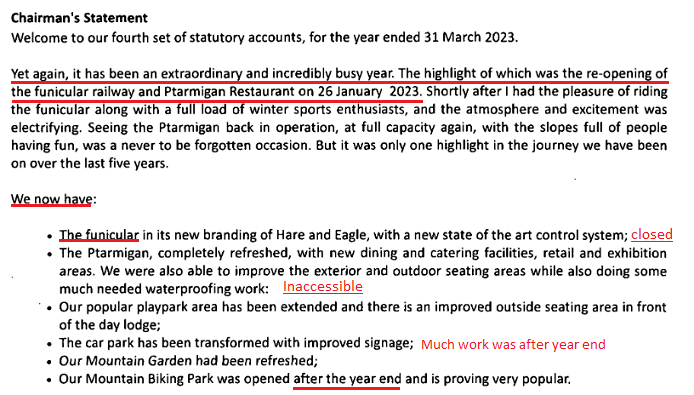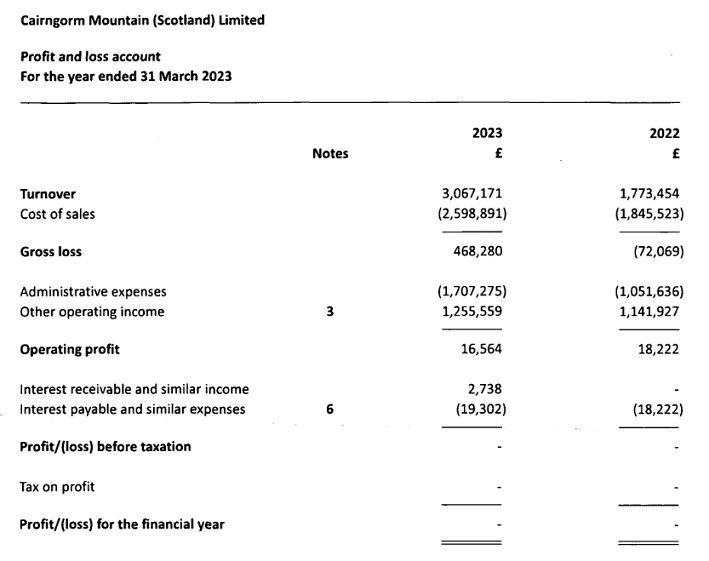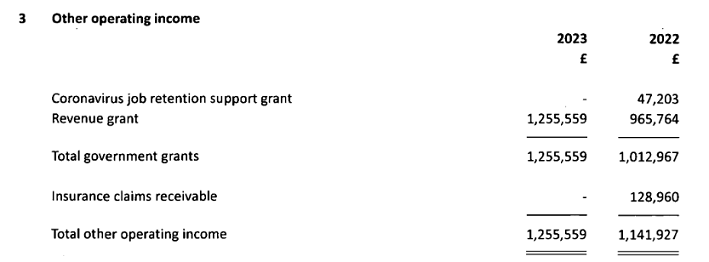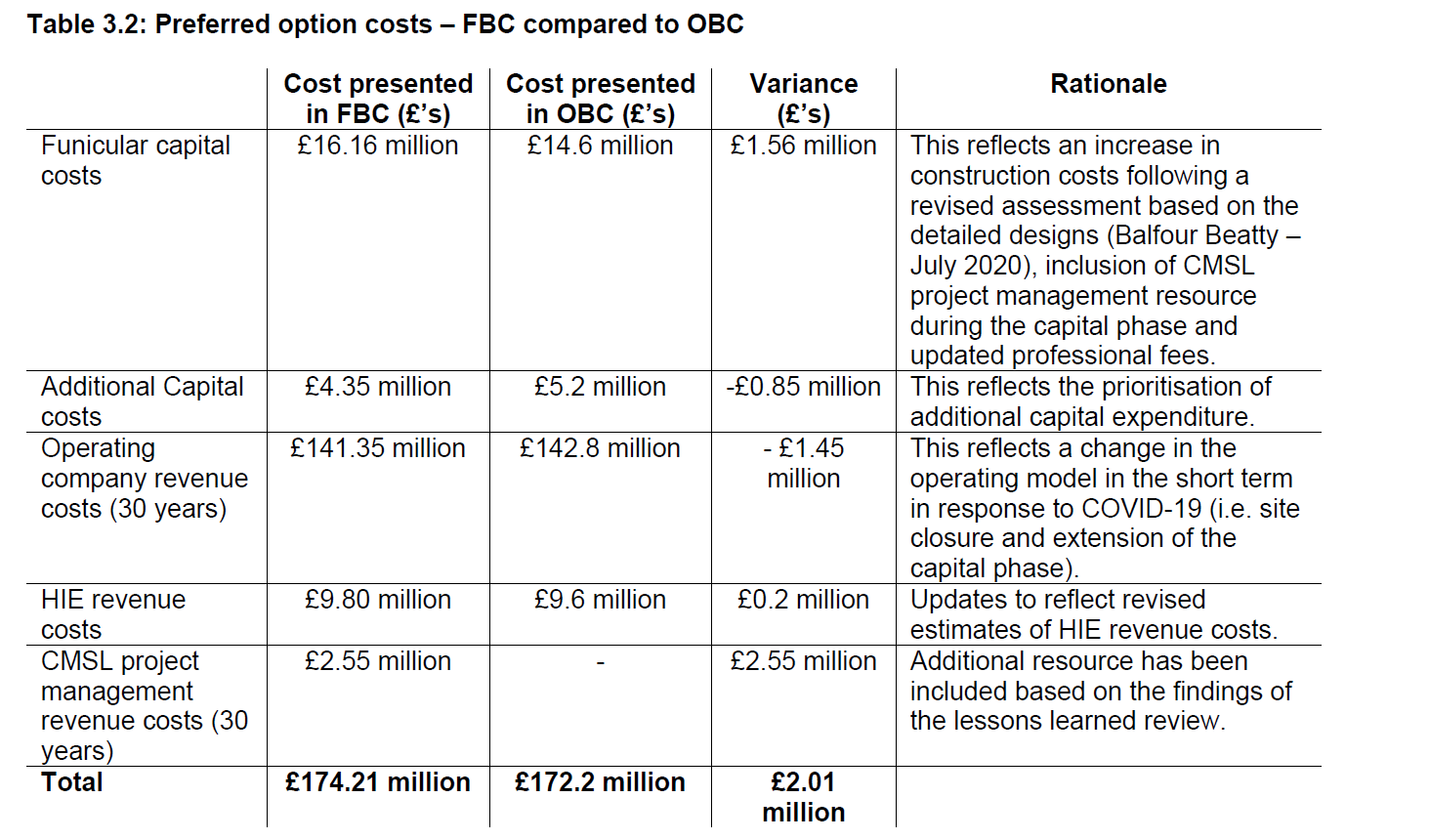Cairngorm Mountain (Scotland) Ltd (CMSL) is Highland and Islands Enterprise (HIE)’s subsidiary that is responsible for operating the facilities at Cairn Gorm, including the funicular. Earlier this month saw the publication (see here) of its accounts for the year to 31st March 2023. They start with this statement signed by Peter Mearns on behalf the board of directors on 19th October 2023:
 It would be ironic if Mr Mearns was one of the very last people to have travelled in the funicular “with a full load of winter sports enthusiasts” because its beams were constructed out of concrete rather than steel and are not fit for purpose (see here). Thank goodness, however, the funicular did not collapse under the weight of all those people and their equipment before HIE eventually decided in August it was unsafe to use.
It would be ironic if Mr Mearns was one of the very last people to have travelled in the funicular “with a full load of winter sports enthusiasts” because its beams were constructed out of concrete rather than steel and are not fit for purpose (see here). Thank goodness, however, the funicular did not collapse under the weight of all those people and their equipment before HIE eventually decided in August it was unsafe to use.
Mr Mearns’ statement tries to have it both ways. He mentions events that happened after year end when they can be spun as positive news but completely fails to mention the closure of the funicular. One month after Mr Mearns’ statement, the funicular remains closed with CMSL unable to say when it might re-open (see here). The longer it takes the funicular to re-open the greater the scandal of the £25m repair bill.
Mr Mearns’ head may be in the sand but his claim that “the facilities at Cairngorm Mountain have never been better” takes some brass neck. Another winter looms with almost no uplift for snowsports. The remuneration of Mr Mearns and his four fellow directors, incidentally, is hidden in the accounts by including the Directors among the 72 employees listed at Note 5 instead of listing their “emoluments” separately.
Meantime, CMSL appears to have almost no income to pay Mr Mearns or anyone else: the Ptarmigan restaurant at the top of the mountain is closed; the tube park has been shut to enable the 72 staff to prepare for snowsports launching on 22nd December; the bike park was open weekends only in November and is now closed for the winter; and the car park is free again to use for the winter season.
Any other company in this position would have gone bust months ago but the CMSL accounts report that the business is a “going concern”:

Effectively this says that however little income CMSL generates for the year from October 2023, when the accounts were issued, it will remain a “going concern” because HIE will spend whatever it takes to keep the business afloat.
This commitment is reflected in CMSL’s latest accounts which, ever since the financial year 2020/21, have been designed to balance, showing no profit and no loss:

This shows CMSL increased its turnover more than the cost of sales in the year to March 2023 but its administrative expenses increased significantly. No explanation is provided for this but the key line enabling the accounts to balance is “Other Operating Income”. As Note 3 explains, this is mainly composed of “revenue grant” or the subsidy that HIE provides its subsidiary:

The amount of revenue grant awarded by HIE increased by c£250k in 2023 compared to the previous financial year. This, however, is not like normal government grants, where fixed amounts are offered to organisations provided they meet certain conditions and the organisation concerned is expected to manage the shortfall. Instead, HIE effectively offers CMSL a series of blank cheques, the final one of which is filled in after year end to ensure the profit and loss line balances exactly.
It is worth contrasting HIE’s largesse at Cairn Gorm – which would surely be against the state aid rules if we were still in the EU – with how they treat Scotland’s other ski centres (Glen Shee is covered by Scottish Enterprise). According to their news release on 30th October (see here), HIE have recently awarded a capital grant of £135k to the Lecht to enable it to make efficiencies which will reduce its carbon imprint. Great stuff and no doubt appreciated by the Lecht but compare that with the sums HIE are pouring into Cairngorm Mountain.
The contrast between what the other ski centres can do with very little compared to the huge sums HIE spends on its own operation is striking but even more striking are the outcomes: the other ski centres are managing to maintain uplift infrastructure in the face of climate change but that on Cairngorm Mountain has collapsed.
Yesterday, one of the MSPs for the Highlands, Edward Mountain, was on Good Morning Scotland (see here at 1:42.00) calling for a public inquiry into the funicular and wanting to know where all the public money has gone.In my view it is HIE’s and local MSP Fergus Ewing’s obsession with the funicular that has destroyed snow sports at Cairn Gorm and destroyed Cairngorm Mountain as a viable business and created the need for endless public subsidy.
The projected figures for that subsidy were set out in the business case to repair the funicular which Mr Ewing, then a Scottish Government Minister, approved in 2020. The public subsidy came to £73.09m over 30 years (see here). That figure, however, assumed the funicular could be repaired for £16.16m, when we now know the costs are at least £25m.

Oversimplifying, the approved level of public subsidy also needs to cover the £4.35m for other refurbishment works, £2.55m Project Management costs etc as outlined in table above. This means that c£41m of public subsidy, or £1.36m a year, is left to cover all other capital investment and operational losses in relation to Cairn Gorm. That is barely enough to cover the £1,255,559 Revenue Grant provided by HIE in the last financial year.
With the funicular broken and no source of income, CMSL’s losses for this financial year are likely to be considerably higher. This suggests that despite the mouth-watering amounts of public subsidy committed by the business case to repair the funicular, it won’t be nearly enough. This is another reason why a public inquiry is now needed, with Mr Ewing required to give evidence under oath, but meantime concerned MSPs like Mr Mountain should be demanding HIE publish a revised business case.

I have it on good authority that the Scottish Government are not prepared to call a public enquiry because ”it would not be a sensible use of public funds” They approved the additional expenditures when the Funicular ‘repair’ bill escalated to way beyond the original estimate. It might have escaped their attention…but….the repair bill of circa £26m has not proved to be ‘sensible use of public funds’ Clearly, the irony of refusing to instigate a public enquiry also escapes them. A number of MSP’s were well briefed on the likely outcome and the fact that the Funicular is not the driver of the local tourist economy, as HIE claim it to be. Regrettably, they chose to ignore the information provided to them and the result of allowing HIE to pursue their nonsensical strategy is now plain for all to see.
Regarding your sentence: “Thank goodness, however, the funicular did not collapse under the weight of all those people and their equipment before HIE eventually decided in August it was unsafe to use.” – Without wanting anyone to be injured, the best event to happen was and would be for a catastrophic incident of structural failure so that this weeping sore can be terminated once and for all.”
It would also make the case for a public enquiry unavoidable but by the time one was set-up, those responsible for this farce would be unable to remember anything, their notebooks will have vanished and the cloud where their emails are stored will have mysteriously evaporated, whilst their bonuses and (possibly dodgy) benefits will be well hidden.
Am I correct in thinking that all this expense now makes the RSPB’s original, radical and easily contracted project to Dopplemayar proposal to tunnel from Rothiemurchus to the top a bargain?